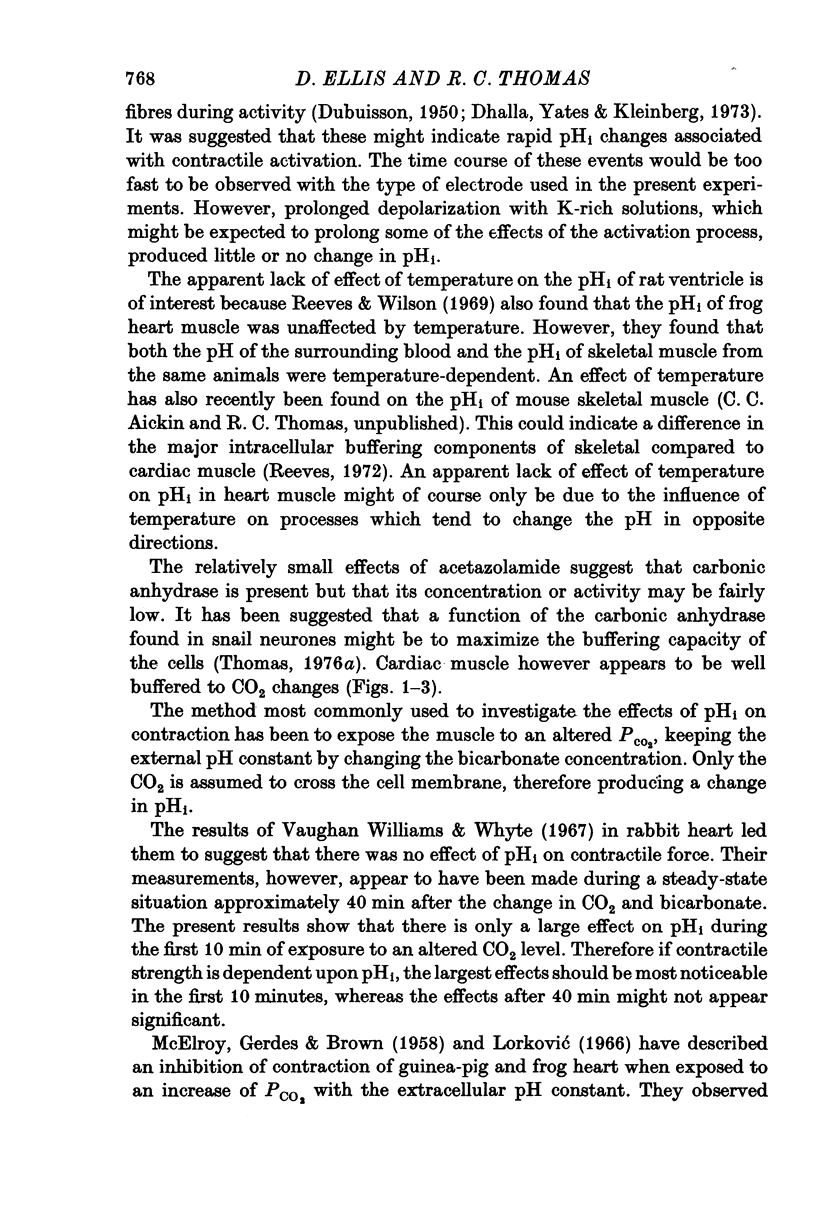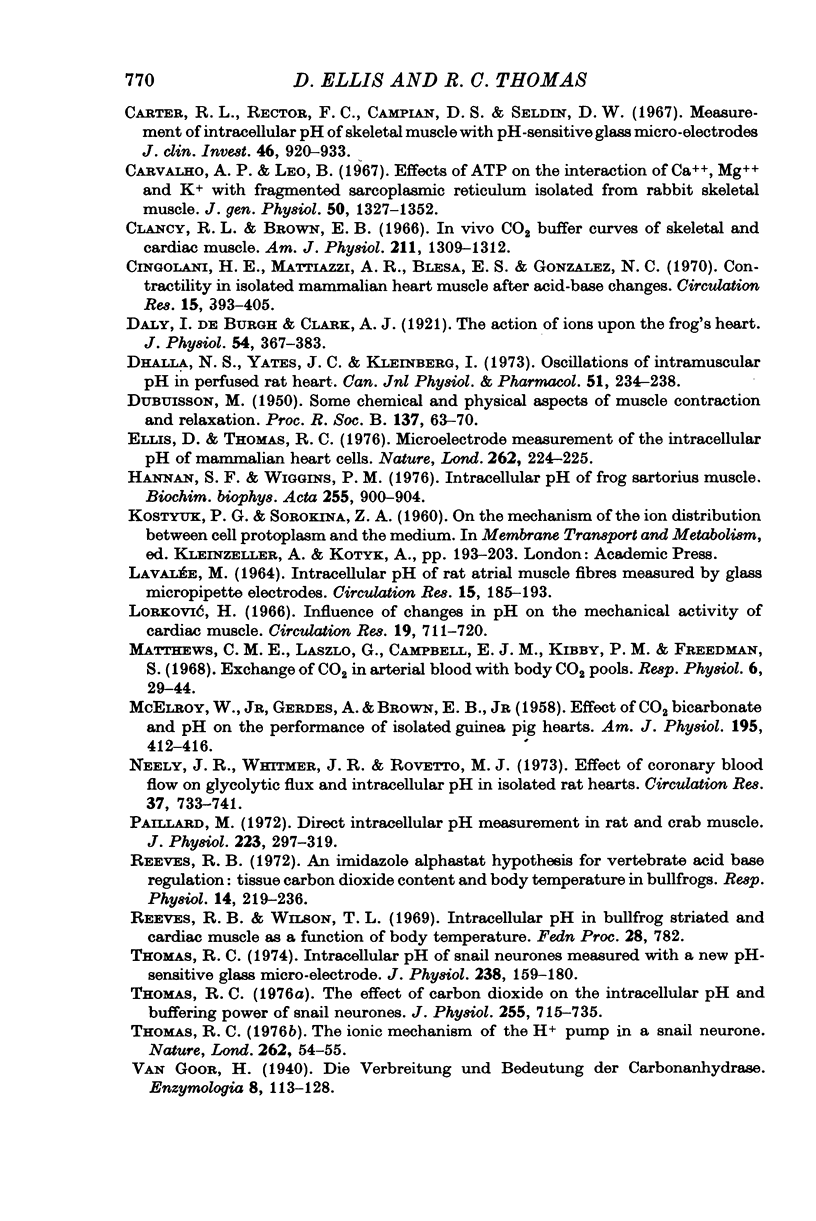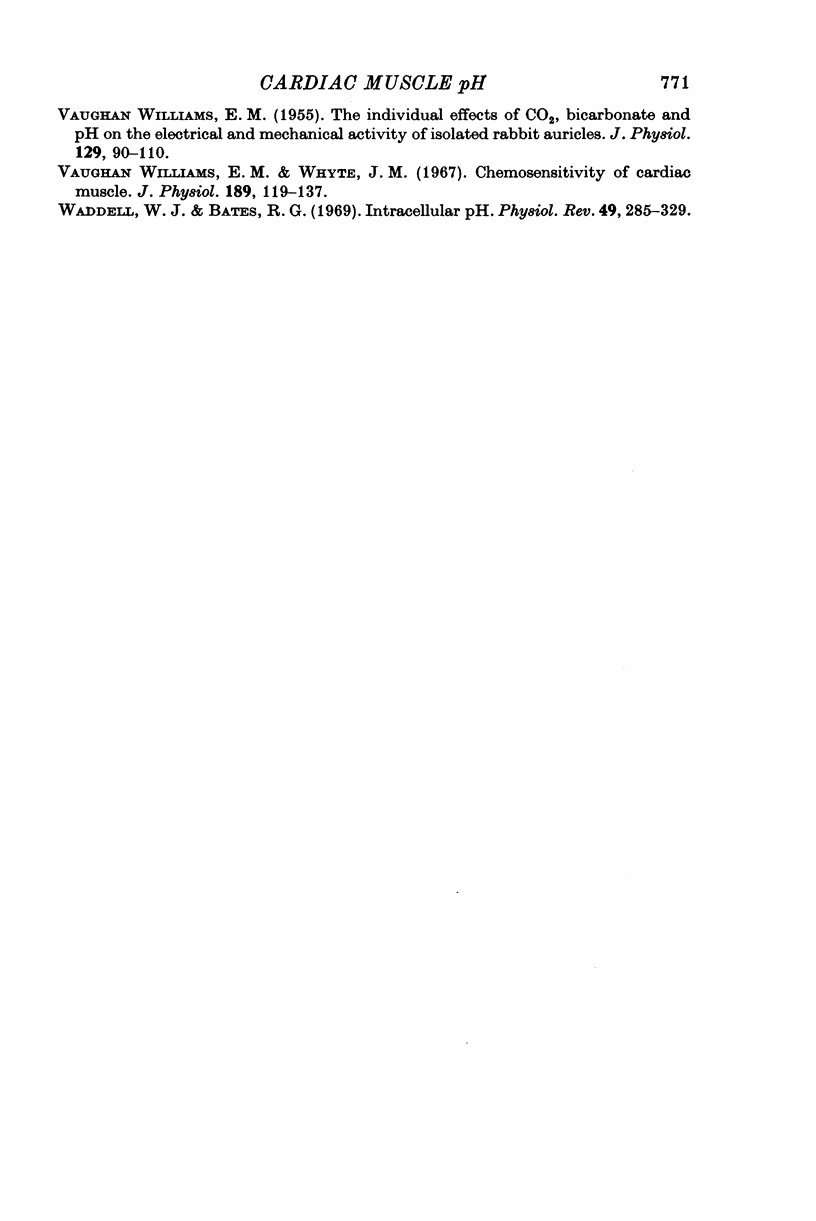Abstract
1. The intracellular pH (pHi) of sheep heart Purkinje fibres and rat, ferret and guinea-pig ventricle has been measured using recessed-tip pH-sensitive micro-electrodes. 2. In the absence of CO2 the pHi was approximately 7-2 in all the preparations used. In 5% CO2 the mean pHi was 7-14 in rat and ferret ventricle and 7-02 in sheep Purkinje fibres. 3. The pHi response to an increase or a decrease in the CO2 level (at constant external pH) was biphasic with a large transient change followed by a partial recovery to a new sustained pHi. 4. The intracellular buffering capacity was 34-8 +/- 2-7 m-equiv H+/pH unit per l. (+/- S.E. of mean) in sheep Purkinje fibres, 76-6 +/- 13-6 in rat ventricle and approximately 69 in ferret ventricle. 5. The pHi of all the preparations tested indicated that H+ ions were not passively distributed across the cell membrane. There was also little or no pHi change produced by depolarization with high K solutions. 6. Short exposures to hypertonic solutions (100 mM sucrose or 50 mM-KCl) produced a decrease in pHi of approximately 0-1 pH units. 7. Acetazolamide slowed the pHi response to CO2 changes. 8. Restoration of the pHi after displacement by increasing the CO2 was not blocked by ouabain or SITS. 9. The relationship between pHi and cardiac contractility is discussed.
Full text
PDF
















Selected References
These references are in PubMed. This may not be the complete list of references from this article.
- Adler S., Anderson B., Zett B. Effect of osmolarity on intracellular pH of rat diaphragm muscle.?22. Am J Physiol. 1975 Mar;228(3):725–729. doi: 10.1152/ajplegacy.1975.228.3.725. [DOI] [PubMed] [Google Scholar]
- Aickin C. C., Thomas R. C. Micro-electrode measurement of the internal pH of crab muscle fibres. J Physiol. 1975 Nov;252(3):803–815. doi: 10.1113/jphysiol.1975.sp011171. [DOI] [PMC free article] [PubMed] [Google Scholar]
- Bicher H. I., Oki S. Intracellular pH electrode. Experiments on the giant squid axon. Biochim Biophys Acta. 1972 Mar 17;255(3):900–904. doi: 10.1016/0005-2736(72)90401-4. [DOI] [PubMed] [Google Scholar]
- CALDWELL P. C. Studies on the internal pH of large muscle and nerve fibres. J Physiol. 1958 Jun 18;142(1):22–62. doi: 10.1113/jphysiol.1958.sp005998. [DOI] [PMC free article] [PubMed] [Google Scholar]
- Carter N. W., Rector F. C., Jr, Campion D. S., Seldin D. W. Measurement of intracellular pH of skeletal muscle with pH-sensitive glass microelectrodes. J Clin Invest. 1967 Jun;46(6):920–933. doi: 10.1172/JCI105598. [DOI] [PMC free article] [PubMed] [Google Scholar]
- Carvalho A. P., Leo B. Effects of ATP on the interaction of Ca++, Mg++, and K+ with fragmented sarcoplasmic reticulum isolated from rabbit skeletal muscle. J Gen Physiol. 1967 May;50(5):1327–1352. doi: 10.1085/jgp.50.5.1327. [DOI] [PMC free article] [PubMed] [Google Scholar]
- Clancy R. L., Brown E. B., Jr In vivo CO-2 buffer curves of skeletal and cardiac muscle. Am J Physiol. 1966 Dec;211(6):1309–1312. doi: 10.1152/ajplegacy.1966.211.6.1309. [DOI] [PubMed] [Google Scholar]
- Daly I. de B., Clark A. J. The action of ions upon the frog's heart. J Physiol. 1921 Mar 15;54(5-6):367–383. doi: 10.1113/jphysiol.1921.sp001938. [DOI] [PMC free article] [PubMed] [Google Scholar]
- Dhalla N. S., Yates J. C., Kleinberg I. Oscillations of intramuscular pH in perfused rat heart. Can J Physiol Pharmacol. 1973 Mar;51(3):234–238. doi: 10.1139/y73-035. [DOI] [PubMed] [Google Scholar]
- Ellis D., Thomas R. C. Microelectrode measurement of the intracellular pH of mammalian heart cells. Nature. 1976 Jul 15;262(5565):224–225. doi: 10.1038/262224a0. [DOI] [PubMed] [Google Scholar]
- Matthews C. M., Laszlo G., Campbell E. J., Kibby P. M., Freedman S. Exchange of 11CO2 in arterial blood with body CO2 pools. Respir Physiol. 1968 Dec;6(1):29–44. doi: 10.1016/0034-5687(68)90017-0. [DOI] [PubMed] [Google Scholar]
- McELROY W. T., Jr, GERDES A. J., BROWN E. B., Jr Effects of CO2, bicarbonate and pH on the performance of isolated perfused guinea pig hearts. Am J Physiol. 1958 Nov;195(2):412–416. doi: 10.1152/ajplegacy.1958.195.2.412. [DOI] [PubMed] [Google Scholar]
- Neely J. R., Whitmer J. T., Rovetto M. J. Effect of coronary blood flow on glycolytic flux and intracellular pH in isolated rat hearts. Circ Res. 1975 Dec;37(6):733–741. doi: 10.1161/01.res.37.6.733. [DOI] [PubMed] [Google Scholar]
- Paillard M. Direct intracellular pH measurement in rat and crab muscle. J Physiol. 1972 Jun;223(2):297–319. doi: 10.1113/jphysiol.1972.sp009848. [DOI] [PMC free article] [PubMed] [Google Scholar]
- Reeves R. B. An imidazole alphastat hypothesis for vertebrate acid-base regulation: tissue carbon dioxide content and body temperature in bullfrogs. Respir Physiol. 1972 Mar;14(1):219–236. doi: 10.1016/0034-5687(72)90030-8. [DOI] [PubMed] [Google Scholar]
- Thomas R. C. Intracellular pH of snail neurones measured with a new pH-sensitive glass mirco-electrode. J Physiol. 1974 Apr;238(1):159–180. doi: 10.1113/jphysiol.1974.sp010516. [DOI] [PMC free article] [PubMed] [Google Scholar]
- Thomas R. C. Ionic mechanism of the H+ pump in a snail neurone. Nature. 1976 Jul 1;262(5563):54–55. doi: 10.1038/262054a0. [DOI] [PubMed] [Google Scholar]
- Thomas R. C. The effect of carbon dioxide on the intracellular pH and buffering power of snail neurones. J Physiol. 1976 Mar;255(3):715–735. doi: 10.1113/jphysiol.1976.sp011305. [DOI] [PMC free article] [PubMed] [Google Scholar]
- VAUGHAN WILLIAMS E. M. The individual effects of CO2, bicarbonate and pH on the electrical and mechanical activity of isolated rabbit auricles. J Physiol. 1955 Jul 28;129(1):90–110. doi: 10.1113/jphysiol.1955.sp005340. [DOI] [PMC free article] [PubMed] [Google Scholar]
- Waddell W. J., Bates R. G. Intracellular pH. Physiol Rev. 1969 Apr;49(2):285–329. doi: 10.1152/physrev.1969.49.2.285. [DOI] [PubMed] [Google Scholar]
- Williams E. M., Whyte J. M. Chemosensitivity of cardiac muscle. J Physiol. 1967 Mar;189(1):119–137. doi: 10.1113/jphysiol.1967.sp008158. [DOI] [PMC free article] [PubMed] [Google Scholar]


